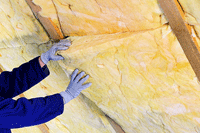Not long ago, the Building Science Corporation (BSC) conducted a thorough study that found that the insulating R-value of most insulation changes with temperatures. The results indicated that people in cold climates are the lucky beneficiaries, because the R-values of most insulation types increased as temperatures fell, but declined as they grew hotter.
This is bad news for Yuma residents because it means that as temperatures climb, the ability of the insulation to protect you from the heat gain in the summer will drop. The R-value refers to how long the insulation can resist temperature chan ge. An R-value of 13, for example, can give you 13 hours of protection against heat transfer, in or out of your home.
ge. An R-value of 13, for example, can give you 13 hours of protection against heat transfer, in or out of your home.
The BSC tested R-13 fiberglass insulation and found its R-value grew to 16 when temperatures were at minus-30 degrees F, but fell to just over 11 at temperatures at 150 degrees. Fortunately, while we never see anything within 50-60 degrees of minus-30 in Southwest Arizona, your attic experiences months of hot temperatures that can reach 150 degrees during the worst of the cooling season.
You can solve this problem with the insulating R-value variability by doing one of two things.
- Increase the amount of insulation in the attic. The U.S. Department of Energy suggests that homes in this region have 8 to 13 inches of insulation in the attic, but adding more will keep your home even cooler. How much you increase the insulation depends on the amount of remaining space in the attic.
- Install an attic fan. Even though the outdoor air is over 100 degrees during the daytime throughout most of the summer, it’s still cooler than the heat that builds in a poorly ventilated attic. Options include a wired fan or a solar fan. These fans will pull cooler air through the attic and can run 24 hours a day to reduce the heat load substantially. You also can opt for a solar fan that will turn off unless you use a storage battery.
To learn more about improving the insulating R-value and lowering conditioning bills in your Yuma area home, please contact us at Hansberger Refrigeration & Electric Company, where we’ve provided superior services since 1952.
Normal
0
false
false
false
EN-US
X-NONE
X-NONE
/* Style Definitions */
table.MsoNormalTable
{mso-style-name:”Table Normal”;
mso-tstyle-rowband-size:0;
mso-tstyle-colband-size:0;
mso-style-noshow:yes;
mso-style-priority:99;
mso-style-parent:””;
mso-padding-alt:0in 5.4pt 0in 5.4pt;
mso-para-margin:0in;
mso-para-margin-bottom:.0001pt;
mso-pagination:widow-orphan;
font-size:10.0pt;
font-family:”Calibri”,”sans-serif”;}
Our goal is to help educate our customers in Yuma, Arizona about energy and home comfort issues (specific to HVAC systems). For more information about R-Value and other HVAC topics, download our free Home Comfort Resource guide.
Image courtesy of Shutterstock

